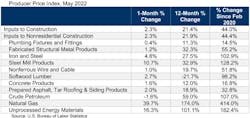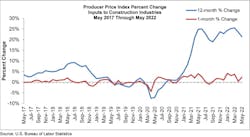Latest from Construction Data
Construction Labor Force Churn Accelerates in January
Sponsored
WASHINGTON, DC — Construction input prices rose 2.3% in May compared to the previous month, according to an Associated Builders and Contractors analysis of U.S. Bureau of Labor Statistics Producer Price Index data released today. Nonresidential construction input prices also increased 2.3% for the month.
Construction input prices are up 21.4% from a year ago, while nonresidential construction input prices are 21.9% higher. Input prices rose in 10 of 11 subcategories in May. The largest price increases were in natural gas (+39.7%) and unprocessed energy materials (+16.3%).
“Inflationary pressures show no signs of abating,” said ABC Chief Economist Anirban Basu. “For months, economists and others have been expecting inflation to peak and then subside. Instead, the Russia-Ukraine war has disturbed markets, driving energy prices higher. Those elevated energy prices are now circulating across the economy, affecting manufacturing and distribution, and there is little prospect for inflation to meaningfully subside during the weeks ahead.
“Federal Reserve policymakers will continue to aggressively combat inflationary pressures,” said Basu. “But what the Federal Reserve most directly affects is demand for goods and services, not supply. By tightening monetary policy and raising interest rates, the Federal Reserve will suppress demand over the rest of the year. Eventually, suppliers will respond to diminished demand. This dynamic will quite likely drive the economy into recession either later this year or at some point in 2023.
“Based on the historical lag between the performance of the economy and nonresidential construction spending, more difficult times could be ahead for contractors in 2024 or 2025,” said Basu. “Looking at the most recent reading of ABC’s Construction Confidence Index, contractors are already seeing momentum slow. The likely exception is public contractors, who will continue to benefit from stepped-up infrastructure spending.”
Visit abc.org/economics for the Construction Backlog Indicator and Construction Confidence Index, plus analysis of spending, employment, job openings, GDP and the Producer Price Index.




